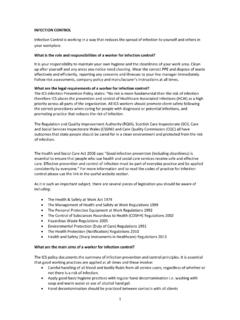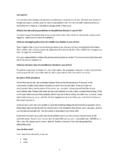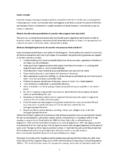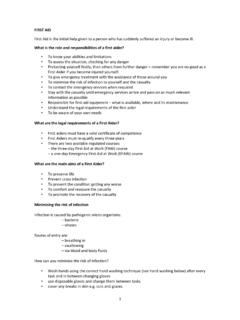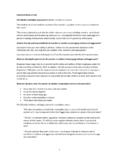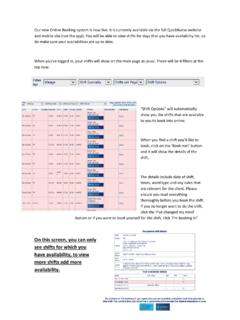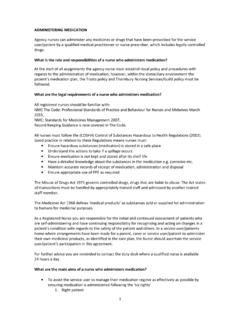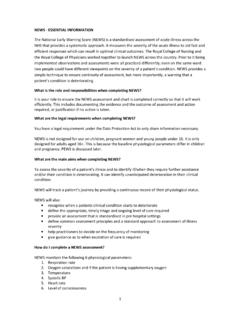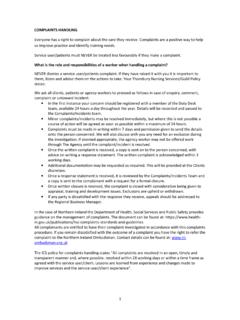Transcription of Equality and Diversity 2016 v2 - Quick Nurse
1 1 Equality AND Diversity Diversity is valuing , welcoming and promoting the wide range of individual difference. Equality is what protects people from being discriminated against for their differences , being fair to everyone. Equality is not about treating everybody the same, but fairly. What is the role and responsibilities of agency staff working in a diverse workplace? All agency staff must treat all service user/patients as individuals, with dignity and with respect. The ICS Equality , Diversity and Human Rights Policy states: Both as a provider of health services and employer of people, ICS is committed to the elimination of discrimination on the basis of gender, marital status, age, disability, race, religion, nationality, ethnicity, sexuality or social class.
2 ICS aims to provide accessible services, delivered in a way that respects the needs of each individual and does not exclude anyone What are the legal requirements of Equality and Diversity ? The Equality Act 2010 replaces nine separate pieces of legislation related to anti-discrimination. It protects people both in the workplace and in wider society from discrimination. It covers discrimination on the grounds of: Race Gender Sexual orientation Disability Religion or beliefs Being a transsexual (where a person proposes to, is in the process of, or has changed their gender legally known as gender reassignment ) Pregnancy or just having had a baby Age (only applicable in the workplace) there are some exemptions to this These are known as protected characteristics.
3 Human Rights Act 1998 The Act came into force in October 2000 and gives everyone the right by law to defend your rights in the courts and public organisations. This means the government, police and local councils must treat everyone equally and with fairness, dignity and respect. The fundamental rights and freedoms are: Right to life Freedom from torture, inhumane, or degrading treatment Liberty and security Freedom from slavery and forced labour Right to a fair trail No punishment without law Respect for your private family life, home and correspondence Freedom of thought, religion or belief Freedom of expression Freedom of assembly and association Right to marry and start a family 2 Protection from discrimination in respect of these rights and freedoms Right to peaceful enjoyment of your property Right to education Right to participate in free elections Mental Capacity Act 2005 You have mental capacity if you are able to make a decision yourself.
4 This can be by communicating verbally, with sign language or even simple movements like squeezing a hand or blinking an eye. You will be able to understand the information, retain it as long as needed to make the decision and weigh up the information. Individuals who cannot do the above would be said to lack capacity . There are many reasons an individual would lack capacity illness, injury, mental health problems or a learning disability. Individuals will be assessed on the capacity and a written assessment will be completed. This will detail if there are times of the day that the individual may be able to think more clearly. The Mental Capacity Act 2005 applies to people aged 16 and over in England and Wales.
5 It protects people with mental health problems, learning disabilities and dementia who do not have the ability to make decisions for themselves. It can also be used as a guide for those who are making the decisions to ensure they are working in the individual s best interest. Northern Ireland has different laws around capacity, Alzheimer s Society have a factsheet N1472, Enduring Power of Attorney and Controllership that details these laws. The Act covers everyday decisions such as personal care, what to eat, drink or wear as well as financial affairs and health and social care needs. The Deprivation of Liberty Safeguards The Deprivation of Liberty Safeguards (DoLS) came into force in England and Wales in April 2009 under amendments to the Mental Capacity Act 2005.
6 They were introduced following a decision in the European Court of Human Rights (ECHR). The ECHR found that our law did not give adequate protection to people who lacked mental capacity to consent to care or treatment, and who needed limits put on their liberty to keep them safe. Article 5 of the Human Rights Act 1998 requires that no one should be deprived of their liberty except in certain, pre-defined, circumstances; there must also be an appropriate, legally based, procedure in place to protect the individual s rights. Who do the safeguards apply to? The safeguards apply to: people in hospital; people in care homes. Both self-funded and publicly funded residents are covered by the safeguards.
7 For people being cared for somewhere other than a care home or hospital, deprivation of liberty will only be lawful with an order from the Court of Protection. What are the main aims of Equality and Diversity ? 3 To encourage individuality and independence by promoting service user/patients preferences, wishes, needs and values at all times, unless it is unsafe to do so. Duty of Care The Social Care Institute for Excellence defines Duty of Care as follows: Duty of Care is defined simply as a legal obligation to: always act in the best interest of individuals and others not act or fail to act in a way that results in harm act within your competence and not take on anything you do not believe you can safely do As an agency worker you must always consider the duty of care you have for your patients.
8 This is not always straight forward as the patient may not want the same as you. Discrimination Discrimination is treating someone unfairly by denying their rights to their choices, wishes, needs and preferences. Direct discrimination is intentional, so for example not encouraging a service user/patient to participate in an activity because they have a disability. Always work in a way that does not discriminate against any of your service users/patients. Indirect discrimination is unintentional or aimed at a group of people rather than an individual. For example, the cook is only in from 11 until 2 so everyone has to have their meal when she is ready. Food and drinks should always be available to everyone, alternatives can be provided if the cook is not in, and meals could be made up and frozen so the staff can get access to a hot meal when the service user/patient wants it.
9 Discrimination can be reduced by practices that are inclusive and support Equality . Challenging discrimination should always be positive. Often when people or practice discriminates against someone it is not intentional. By challenging in a positive way you are more likely to get positive results. Reporting & Recording Challenge comments, attitudes and behaviours that you believe are discriminatory. If you cannot do this directly with the person, or you need more advice, report it to the Duty Desk. Labelling Labelling is when you define a person because of an illness, disability or their cultural habits someone who takes drugs could be labelled the drug addict, another person who drinks may be labelled the alcoholic or a person with schizophrenia could be labelled as the schizophrenic.
10 Labelling can have powerful negative implications and leads to unfair treatment, it is never acceptable. Bullying & Harassment 4 Bullying and harassment are a misuse of power and/or influence over another person. It could be in the form of exclusion, teasing, ignoring or threatening. It is NEVER acceptable. Make sure you have read and understood your Thornbury Nursing Services/Guild policy as this gives specific guidance should you have any concerns. Stereotyping Stereotyping is when you categorise a person due to the group they are in. teenagers all go out drinking on a Friday night and cause trouble or all Italians eat pizza. This is incorrect and not focusing on the individual, not every teenager goes out on a Friday night and causes trouble and neither do Italians all eat pizza.
